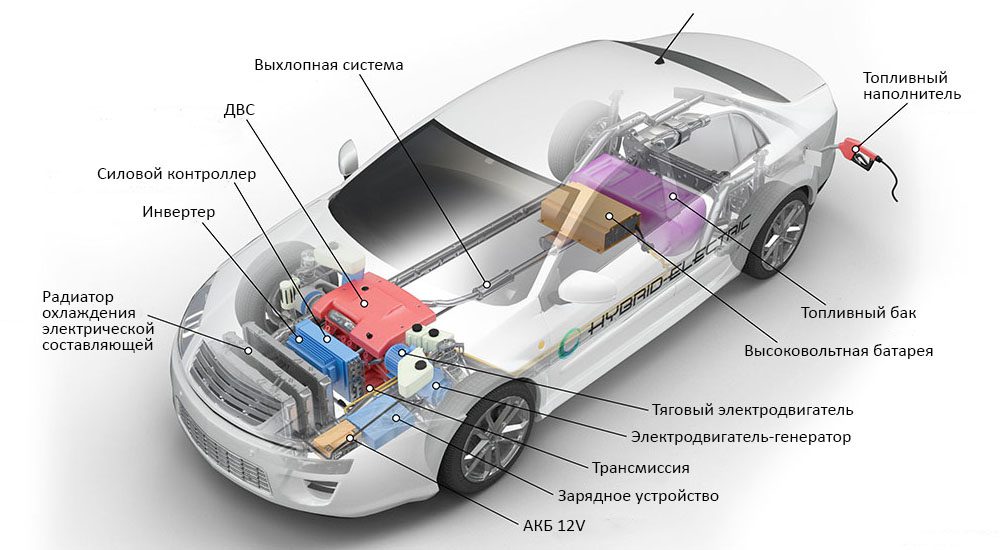
How different hybrid technologies work in cars
Content
Currently, the democratized hybrid car is in its prime, a transition period between thermal and electric drive, so cars use these two technologies at the same time. However, you should be aware that this universal term hides a variety of technologies, ranging from anecdotal hybrids to "heavy" hybrids. So let's take a look at the various hybridizations that exist, as well as all the pros and cons of the latter.
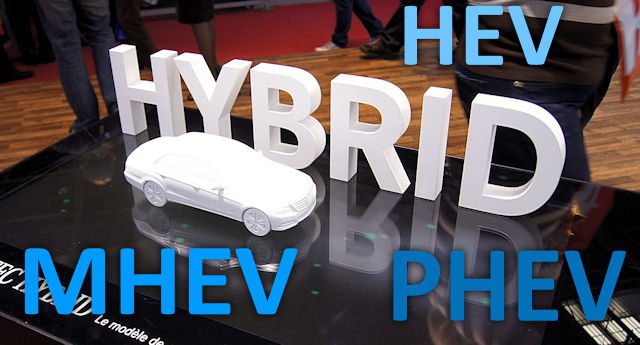
Before considering the various topologies and technical architectures of hybrid vehicles (different assemblies), we will first perform the classification by device calibration.
Different levels of hybridization
Hybrid very weak MHEV ("microhybrid" / "FALSE" hybridization)
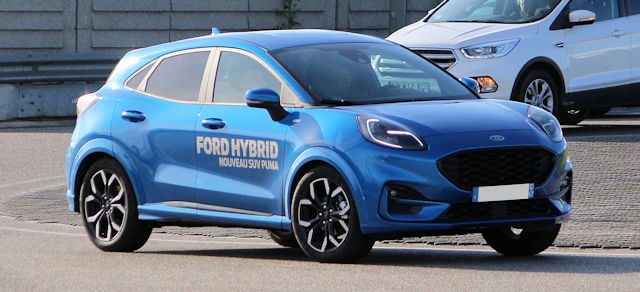
| Voltage: | Low / 48V |
| Rechargeable: | no |
| Electric driving: | no |
| overweight: | <30kg |
| Battery capacity: | <0.8 Qtq |
Certain levels of hybridization are very light, this in particular takes place with 48 volts at the level of the crankshaft pulley (before this was limited to stopping and starting, the generator-starter did not receive current to be able to help the engine.. Motor) ... Equipped with microscopic batteries less than 0.7 kWhI do not consider this technology to be truly hybridization. The forces generated by an electrical device are too anecdotal to be judged as such. And since the torque is transmitted to the wheels through the motor (through the damper pulley), 100% electric movement will obviously not be possible. Beware of growers who add tons to this kind of technology, allowing you to believe in consistent hybridization (in fact, that's all it takes to save a few grams for environmental penalties). Therefore, I want to distinguish this hybridization from subsequent ones.
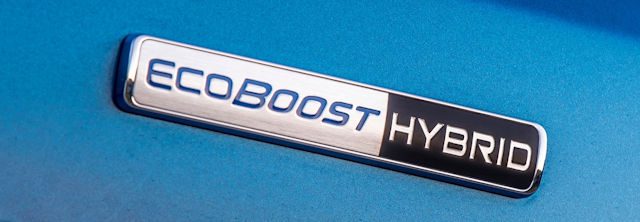
Beware of manufacturers who abuse this, MHEV hybridization can be described as "fiction" because it is so anecdotal.
You will recognize them by the 48V or MHEV nomenclature. We can cite, for example, e-TSI or Ecoboost MHEV.
Mild hybrid ("REAL" hybrid) HEV
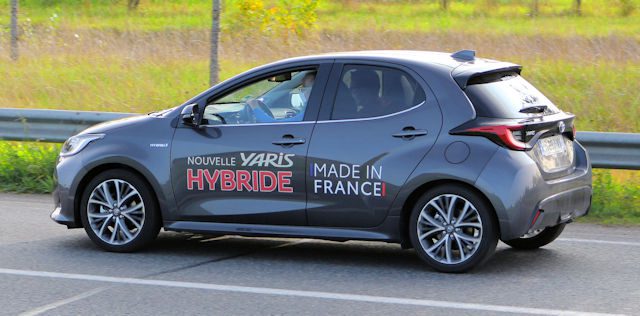
| Voltage: | High / ~ 200 V |
| Rechargeable: | no |
| Electric driving: | Yes |
| overweight: | From 30 to 70 kg |
| Battery capacity: | From 1 to 3 kWh |
Therefore, we are no longer here in
very
light that promises too little (we go from less than 0.5 kWh to values in the range from From 1 to 3 kWh, or from 1 to 3 km on a fully electric). Thus, here we are talking about easy hybridization, but still sequential hybridization (to be related to the category indicated after [PHEV], here it is a variant of light PHEV and therefore not rechargeable). Thus, we can drive completely on electricity, even if it is a very short distance. The aim here is primarily to reduce consumption, not to cover 100% of the electric travel distance. The most favorable context is spark plugs, the environment in which modern, downsized direct injection engines become the most energy intensive (richer engine cooling mixture that mostly favors lean burn, but this is only part of the explanation). So you get almost nothing on expressways: national / departmental / motorways. In this context, diesel fuel remains more profitable (and hence for the planet!).
The most famous of all is Toyota's HSD hybridization because it's been around for years! Therefore, it is also the most common ... Its reliability is well known and its work is very thoughtful.
More recently, we will be referring to the Renault E-Tech hybrid, which, like Toyota, is embodied in proprietary technologies that no one else has (here you are not the equipment supplier, but the brand that even developed it). ... It's the same with the Mitsubishi IMMD.
PHEV plug-in hybrid ("REAL" hybrid)
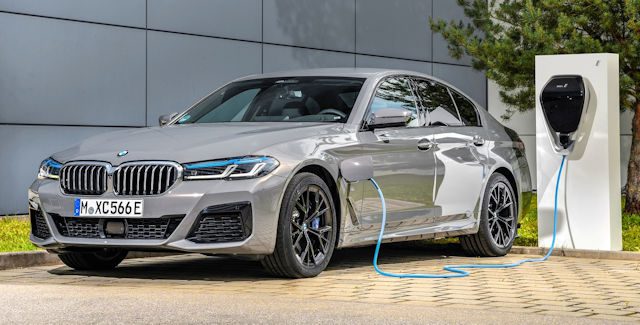
| Voltage: | Very high / ~ 400 V |
| Rechargeable: | Yes |
| Electric driving: | Yes |
| overweight: | From 100 to 500 kg |
| Battery capacity: | From 7 to 30 kWh |
Such a hybrid can be qualified as "heavy", because the on-board equipment is far from being funny and light (from 100 to 500 kg extra: battery, power electronics and electric motor) ...
We then load the battery, which can range from From 7 to 30 kWh, it will be enough to drive from 20 to almost 100 km, depending on the car (the most modern one).
As with other hybridization calibrations, we have a variety of technologies. We still find the Renault E-Tech hybrid, but here it is connected to a large rechargeable battery via an external outlet. Because if the Clio has a 1.2 kWh lightweight version, the Captur or Mégane 4 can benefit from the 9.8 kWh version, which we would therefore qualify as a heavy hybrid. The X5 45e will benefit from a 24 kWh version, which is enough to cover 90 km on all-electric.
This type of car can accelerate to 130 km / h at all electric power, the manufacturers seem to have fixed themselves at this pace (they offer almost everything the same).
Most hybrids of this type tend to have an electric motor located opposite the clutch / torque converter, hence between the engine and the gearbox. Renault electrified the gearbox and removed the clutch, and Toyota uses a planetary gear train to combine thermal and electrical forces on the wheels (HSD is no longer lit when you add an 8.8 kWh battery to it. A battery that can be recharged via an outlet).
Different architectures of hybrid vehicles
Luminaire assembly MHEV / Micro hybrid 48V
This system operates at lower voltages, namely 24 or 48 V (almost always 48 V). This time we are talking about equipping the car with an "excellent" stop and start system, which is not limited to restarting the car. What's more, it helps the heat engine even when it is in motion. This system does not allow you to operate completely electrically, but it turns out to be a flexible and easy process that can be installed anywhere! Ultimately, this is perhaps the smartest system of all, even if at first glance it seems a little easy to you. But it is the light aspect that makes it interesting ...
Parallel hybrid layout
In this configuration, two motors can rotate the wheels, either only thermal, or only electric (on full hybrids), or both at the same time. The accumulation of powers will depend on certain variables (see below: accumulation of powers). Also note that some of the components may be slightly different, but the logic remains the same: electric and thermal drive the wheels through the gearbox. An example is German hybrids such as the e-Tron / GTE systems. This system is spreading more and more and should become the majority.
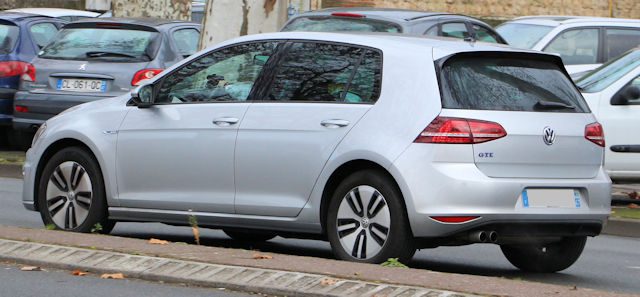
Read: details of the operation of hybridization e-Tron (transverse and longitudinal) and GTE.
Please note that I decided to make my diagrams with a transverse engine arrangement, that is, most of our cars. Luxury sedans are usually in a longitudinal position. Also note that I am specifying here a clutch that disconnects the engine from the transmission (so it would be necessary to add a clutch or converter between the electric motor and the gearbox in addition to the circuit. But some people connect the electric motor directly to the gearbox., Example with E-Tense and HYbrid / HYbrid4 from PSA)
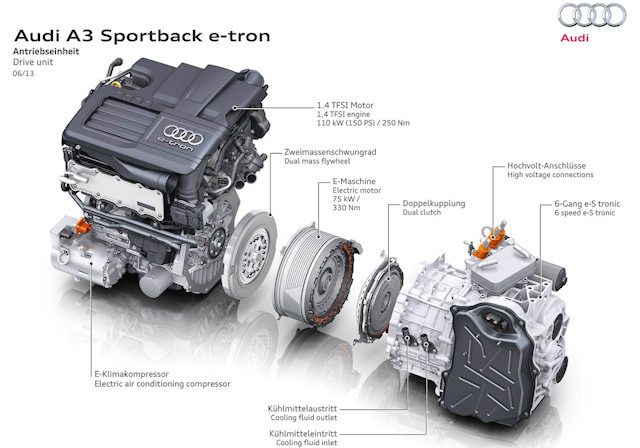

This is a system on a Mercedes with a longitudinal engine. I have highlighted in red the electric motor opposite the torque converter. On the right is the gearbox (planetary, because BVA), and on the left is the engine.
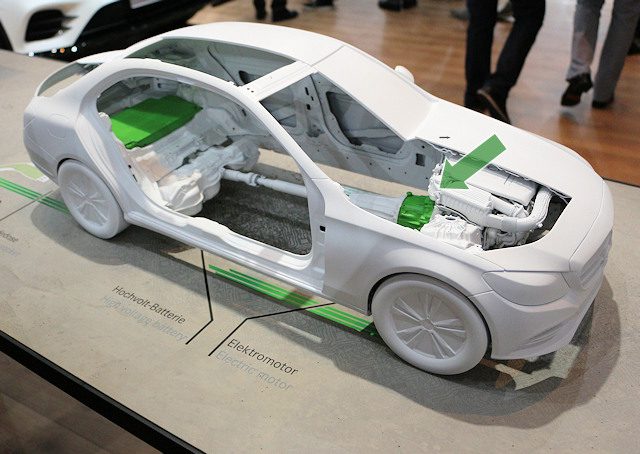
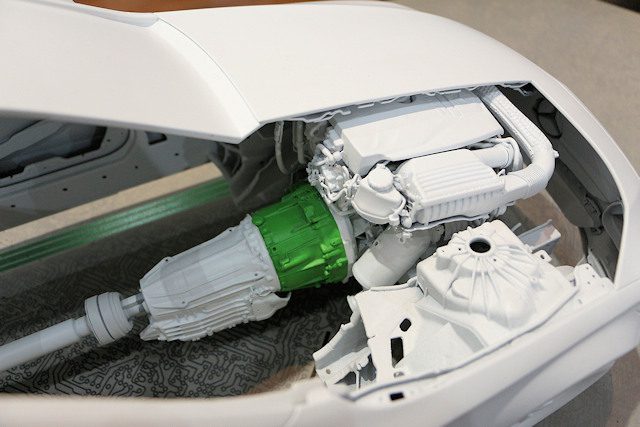
Hybrid Mount Series
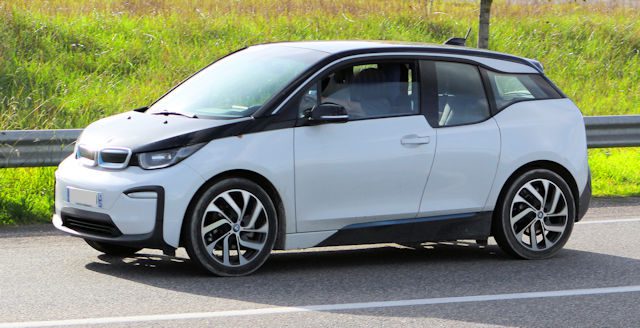
Other systems saw this differently, as only the electric motor can drive the wheels. Then the heat engine will only serve as an electric generator for recharging the batteries. By itself, the engine has no connection with the transmission and therefore with the wheels, it is unlikely that it is part of the mechanics, so much so that it is put aside. Here you can refer to the BMW i3 or the Chevrolet Volt / Opel Ampera (binoculars).
Here, only the electric motor can move the car, since it is the only one that connects to the wheels. We can assume that this is an electric vehicle, which will have an additional generator to increase autonomy. A heat engine that generates hundreds of horsepower would not be of much use since it only serves to generate electricity.
Series-parallel installation
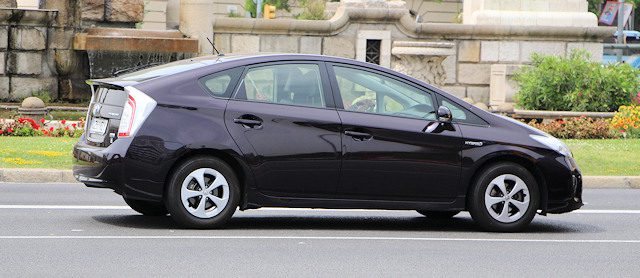
Here you will probably have more trouble grasping the concept quickly ... Indeed, it turns out to be as smart as it is difficult to understand. Part of the reason lies in the planetary gear train, which allows the power to be stored on a single shaft from two different sources: an electric motor and a heat engine. It is also the complexity of the number of moving elements that work together, as well as the many modes of operation that make the system globally difficult to learn (a mixture of complex concepts related to the transmission chain, in particular the epicyclic train, but also the use of electromagnetic force as for generating current and for transmitting torque with a clutch effect). It is called sequential / parallel because it slightly combines the two modes of operation (which complicates things ...).
Read more: How the Toyota Hybrid (HSD) Works.
Build varies from generation to generation, but the principle is the same
The actual diagram is upside down because when viewed from the opposite side ...
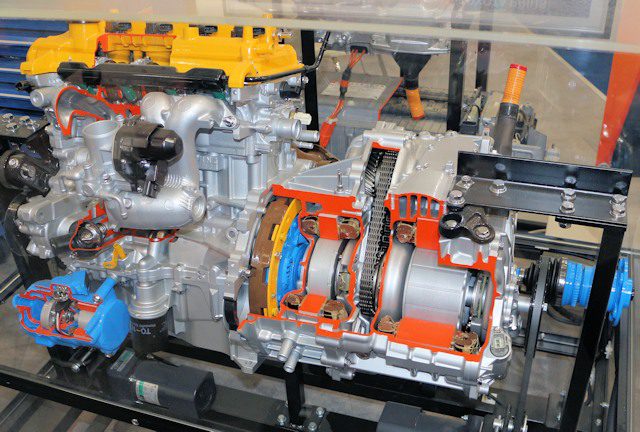
Dissociated / Differentiated Hybrid
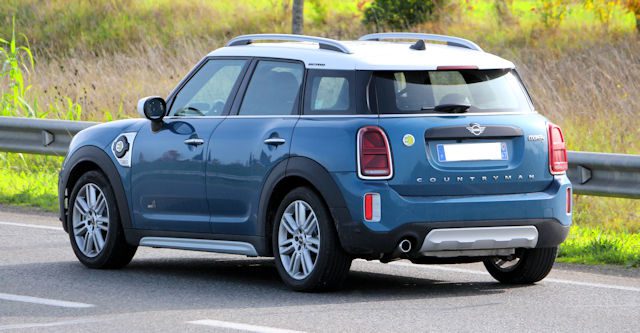
We can cite, for example, the PSA (or rather Aisin) Hybrid4 system, in which the electric motor is for the rear wheels, while the front is conventional with a heat engine (sometimes it is also a hybrid in the front like the Rav4 HSD or even the second generation HYbrid2 and HYbrid4 in some cases).
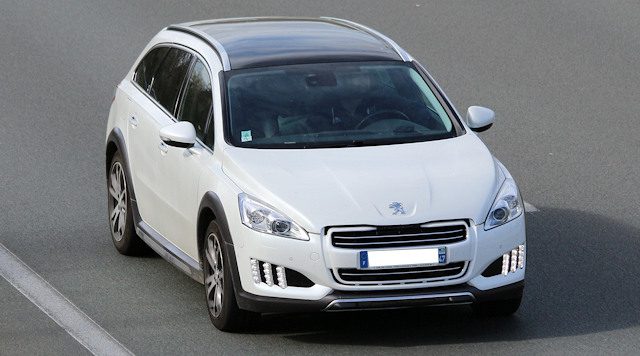
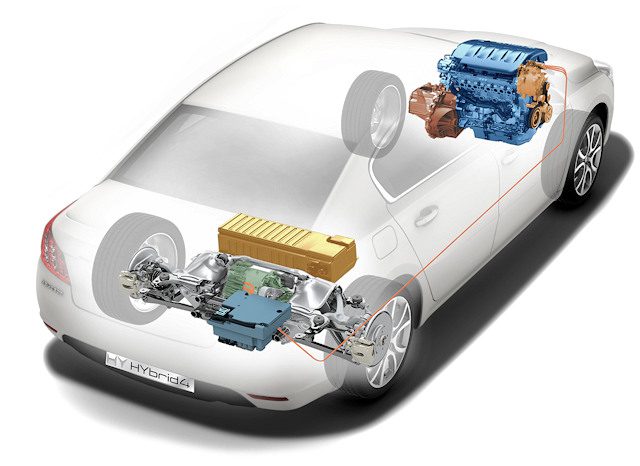
Different levels of hybridization
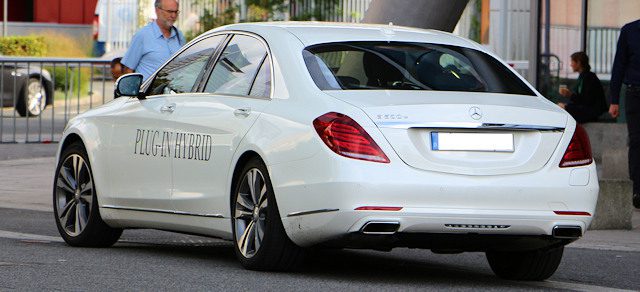
Before looking at the different ways to create a hybrid vehicle, let's first look at a vocabulary describing the various possible hybridizations:
- Full hybrid : literally "complete hybrid": electric with at least 30% of the total capacity. The electric motor (and there may be several of them) is capable of autonomously providing movement for several kilometers.
- Plug-in hybrid : Full plug-in hybrid. The batteries can be connected directly to the mains.
- Soft hybrid / Microhybrid : In this case, the car will not be able to drive completely on electricity, even for short distances. Thus, the thermal imager will always be on. Modern 48V versions even systematically assist the engine via a damper pulley. In the first versions of the 2010s, it was limited to the improved Stop and Sart, because it was controlled by a generator-starter, and not a regular starter (so we can recover energy during deceleration, which could not be the case with a classic starter of course)
Why doesn't strength build up all the time?
In the case of a hybrid driven by an electric motor, which itself is charged by a thermal generator (or engine ...), it is easy to understand that nothing needs to be done ... Let the thermal power be 2 or 1000 horsepower. will not change anything, since it is used only for recharging the batteries. Basically can only be played at reload speed.
For a more traditional system (a car of a traditional design with a supporting electric motor) the power of the electric and heat engine accumulate but it does not have to result in a simple resignation.
Indeed, several factors can influence the cumulation, for example:
- System layout (will the electric drive drive the same wheels as the thermal imager? Not on the Hybrid4, e.g. parallel hybrid or series-parallel)
- The power of the battery (powering the electric motor) plays a very important role. Because unlike a thermal, which is powered by fuel from a tank (2 liters is enough to power a 8 hp V500 for a few seconds), the electric motor will not be able to deliver all of its power if the battery is not enough (at least as much the same as the engine to be powered), which is the case on some models. Compared to a diesel locomotive, it's as if fuel consumption were limited ...
- Specifications of two coupled motors. The engine does not develop the same power over the entire speed range (the engine is said to have X horsepower at X rpm, power that becomes different at all Y / min). Thus, when two motors are combined, the maximum power does not reach the maximum power of the two motors. Example: heat output 200 HP at 3000 rpm in combination with an electric output of 50 hp. at 2000 rpm it will not be able to give 250 hp. at 3000 rpm, since the electric motor had a maximum power (50) at 2000 t / min. At 3000 rpm it will only develop 40 hp, so 200 + 40 = 240 hp.

All comments and reactions
Dernier comment posted:
Emryspro (Date: 2021, 06:30:07)
Lexus RX 400h 2010
I have a problem with charging a 12V battery. Need help please
Il I. 1 reaction (s) to this comment:
- Administrator SITE ADMINISTRATOR (2021-07-01 10:32:38): Since there is no alternator, it is connected to the power electronics that control the electrical flows.
(Your post will be visible under the comment after verification)
Write a comment
Which of these brands inspire you the most when it comes to luxury?
